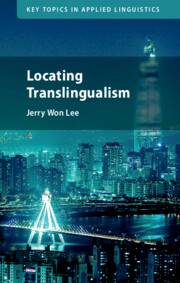Book contents
- Locating Translingualism
- Key Topics In Applied Linguistics
- Locating Translingualism
- Copyright page
- Dedication
- Contents
- Figures
- Acknowledgments
- Notes on the Text
- Introduction
- 1 Translingualism and the Locations of Culture
- 2 Locating Global Korea
- 3 Encountering the Unfamiliar: Languaging Culture
- 4 Visible Nation: Scaling Culture
- 5 Semiotic Excess: Tracing Culture
- Conclusion: More Locations of Culture
- References
- Index
5 - Semiotic Excess: Tracing Culture
Published online by Cambridge University Press: 31 March 2022
- Locating Translingualism
- Key Topics In Applied Linguistics
- Locating Translingualism
- Copyright page
- Dedication
- Contents
- Figures
- Acknowledgments
- Notes on the Text
- Introduction
- 1 Translingualism and the Locations of Culture
- 2 Locating Global Korea
- 3 Encountering the Unfamiliar: Languaging Culture
- 4 Visible Nation: Scaling Culture
- 5 Semiotic Excess: Tracing Culture
- Conclusion: More Locations of Culture
- References
- Index
Summary
This chapter considers the excess of signification, or the semiotic “traces” of global Korea. It first explores the question of the trace in relation to conspicuous municipal designations of Korean spaces in various Koreatowns, which are in turn juxtaposed with the Gwanghwamun in Seoul, a gate to the royal Gyeongbokgung Palace that has been destroyed, relocated, and restored over the years. The chapter then examines how cultural meaning emerges through semiotic traces that would normally be dismissed as having any significatory value, focusing on the case of European semiosis and the role it plays in signifying Koreanness. Finally, it turns to the unusual case of signage in bathrooms of restaurants and other establishments advising patrons to not flush paper down the toilet, reflective of a uniquely Korean preoccupation that can be traced to the 1988 Olympics in Seoul. These examples collectively show that Korea can be encountered through semiotic traces that seem to have nothing to do with Korea at all. This in turn not only raises questions about what Korea is but also invites considerations of what to look for when trying to make sense of Korea or another cultural entity.
Keywords
- Type
- Chapter
- Information
- Locating Translingualism , pp. 140 - 170Publisher: Cambridge University PressPrint publication year: 2022



